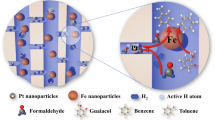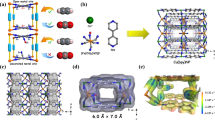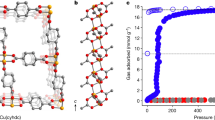Abstract
Industrial processes prominently feature π-acidic gases, and an adsorbent capable of selectively interacting with these molecules could enable important chemical separations1,2,3,4. Biological systems use accessible, reducing metal centres to bind and activate weakly π-acidic species, such as N2, through backbonding interactions5,6,7, and incorporating analogous moieties into a porous material should give rise to a similar adsorption mechanism for these gaseous substrates8. Here, we report a metal–organic framework featuring exposed vanadium(ii) centres capable of back-donating electron density to weak π acids to successfully target π acidity for separation applications. This adsorption mechanism, together with a high concentration of available adsorption sites, results in record N2 capacities and selectivities for the removal of N2 from mixtures with CH4, while further enabling olefin/paraffin separations at elevated temperatures. Ultimately, incorporating such π-basic metal centres into porous materials offers a handle for capturing and activating key molecular species within next-generation adsorbents.
This is a preview of subscription content, access via your institution
Access options
Access Nature and 54 other Nature Portfolio journals
Get Nature+, our best-value online-access subscription
$29.99 / 30 days
cancel any time
Subscribe to this journal
Receive 12 print issues and online access
$259.00 per year
only $21.58 per issue
Buy this article
- Purchase on Springer Link
- Instant access to full article PDF
Prices may be subject to local taxes which are calculated during checkout




Similar content being viewed by others
Data availability
The supplementary materials contain complete experimental and spectral details for all new compounds reported herein. Crystallographic data are available free of charge from the Cambridge Crystallographic Data Centre (CCDC). The CCDC numbers for the activated structure and for the N2-dosed structure are 1971589 and 1971588, respectively.
References
Sholl, D. S. & Lively, R. P. Seven chemical separations to change the world. Nature 532, 435–438 (2016).
Materials Separation Technology: Energy and Emission Reduction Opportunities (US Department of Energy, 2005).
Rufford, T. E. et al. The removal of CO2 and N2 from natural gas: a review of conventional and emerging process technologies. J. Pet. Sci. Eng. 94, 123–154 (2012).
Eldridge, R. B. Olefin/paraffin separation technology: a review. Ind. Eng. Chem. Res. 32, 2208–2212 (1993).
Hoffman, B. M., Lukoyanov, D., Yang, Z.-Y., Dean, D. R. & Seefeldt, L. C. Mechanism of nitrogen fixation by nitrogenase: the next stage. Chem. Rev. 114, 4041–4062 (2014).
Crans, D. C., Smee, J. J., Gaidamauskas, E. & Yang, L. The chemistry and biochemistry of vanadium and the biological activities exerted by vanadium compounds. Chem. Rev. 104, 840–902 (2004).
MacKay, B. A. & Fryzuk, M. D. Dinitrogen coordination chemistry: on the biomimetic borderlands. Chem. Rev. 104, 385–402 (2004).
Lee, K. et al. Design of a metal–organic framework with enhanced back bonding for separation of N2 and CH4. J. Am. Chem. Soc. 136, 698–704 (2014).
Furukawa, H., Cordova, K. E., O’Keefe, M. & Yaghi, O. M. The chemistry and applications of metal–organic frameworks. Science 341, 1230444 (2013).
Li, J. R., Kuppler, R. J. & Zhou, H. C. Selective gas adsorption and separation in metal–organic frameworks. Chem. Soc. Rev. 38, 1477–1504 (2009).
Bloch, E. D. et al. Hydrocarbon separations in a metal–organic framework with open iron(ii) sites. Science 335, 1606–1610 (2012).
Cadieu, A., Adil, K., Bhatt, P. M., Belmabkhout, Y. & Eddaoudi, M. A metal–organic framework-based splitter for separating propylene from propane. Science 353, 137–140 (2016).
Lee, K., Howe, J. D., Lin, L.-C., Smit, B. & Neaton, J. B. Small-molecule adsorption in open-site metal–organic frameworks: a systematic density functional theory study for rational design. Chem. Mater. 27, 668–678 (2015).
Poloni, R., Lee, K., Berger, R. F., Smit, B. & Neaton, J. B. Understanding trends in CO2 adsorption in metal–organic frameworks with open-metal sites. J. Phys. Chem. Lett. 5, 861–865 (2014).
Cotton, F. A. et al. Four compounds containing oxo-centered trivanadium cores surrounded by six µ,η2-carboxylato groups. Inorg. Chem. 25, 3505–3512 (1986).
Denysenko, D., Grzywa, M., Jelic, J., Reuter, K. & Volkmer, D. Scorpionate-type coordination in MFU-4lmetal–organic frameworks: small-molecule binding and activation upon the thermally activated formation of open metal sites. Angew. Chem. Int. Ed. Engl. 53, 5832–5836 (2014).
Yoon, J. W. et al. Selective nitrogen capture by porous hybrid materials containing accessible transition metal ion sites. Nat. Mater. 16, 526–531 (2017).
Caventi, S., Grande, C. A. & Rodrigues, A. E. Separation of CH4/CO2/N2 mixtures by layered pressure swing adsorption for upgrade of natural gas. Chem. Eng. Sci. 61, 3893–3906 (2006).
Lokhandwala, K. A. et al. Membrane separation of nitrogen from natural gas: a case study from membrane synthesis to commercial deployment. J. Membr. Sci. 346, 270–279 (2010).
Saha, D., Grappe, H. A., Chakraborty, A. & Orkoulas, G. Postextraction, separation, on-board storage, and catalytic conversion of methane in natural gas: a review. Chem. Rev. 116, 11436–11499 (2016).
Kuznicki, S. M. et al. A titanosilicate molecular sieve with adjustable pores for size-selective adsorption of molecules. Nature 412, 720–724 (2004).
Bartholomew, E. R., Volpe, E. C., Wolczanski, P. T., Lobkovsky, E. B. & Cundari, T. R. Selective extraction of N2 from air by diarylamine iron complexes. J. Am. Chem. Soc. 135, 3511–3527 (2013).
Rieth, A. J., Tulchinsky, Y. & Dincă, M. High and reversible ammonia uptake in mesoporous metal–organic frameworks with open Mn, Co, and Ni sites. J. Am. Chem. Soc. 138, 9401–9404 (2016).
Bechlars, B. et al. High-spin ground states via electron delocalization in mixed-valence imidazolate-bridged divanadium complexes. Nat. Chem. 2, 362–368 (2010).
Cotton, F. A. et al. Structural studies of the vanadium(ii) and vanadium(iii) chloride tetrahydrofuran solvates. J. Chem. Soc. Chem. Commun. 23, 1377–1378 (1983).
Gonzalez, M. I. et al. Structural characterization of framework-gas interactions in the metal–organic framework Co2(dobdc) by in situ single-crystal X-ray diffraction. Chem. Sci. 8, 4387–4398 (2017).
Fonseca, A., Lledos, B., Pullumbi, P., Lignieres, J. & Nagy, J. B. 15N-NMR characterization and quantitative NMR determination of nitrogen adsorbed in MX zeolites. Surf. Sci. Catal. 125, 229–236 (1999).
Reed, D. A. et al. Reversible CO scavenging via adsorbate-dependent spin state transitions in an iron(ii)–triazolate metal–organic framework. J. Am. Chem. Soc. 138, 5594–5602 (2016).
Li, B. et al. Introduction of pi-complexation into porous aromatic framework for highly selective adsorption of ethylene over ethane. J. Am. Chem. Soc. 136, 8654–8660 (2014).
Ren, T., Patel, M. & Blok, K. Olefins from conventional and heavy feedstocks: energy use in steam cracking and alternative processes. Energy 31, 425–451 (2006).
Reed, D. A. et al. A spin transition mechanism for cooperative adsorption in metal–organic frameworks. Nature 550, 96–100 (2017).
Edema, J. J. H. et al. Novel vanadium(ii) amine complexes: a facile entry in the chemistry of divalent vanadium. Synthesis and characterization of mononuclear L4VCl2 [L=amine, pyridine]: X-ray structures of trans-(TMEDA)2VCl2 [TMEDA=N,N,N′,N′-tetramethylethylenediamine] and trans-Mz2V(py)2 [Mz=o-C6H4CH2N(CH3)2, py=pyridine]. Inorg. Chem. 29, 1302–1306 (1990).
Denysenko, D. et al. Elucidating gating effects for hydrogen sorption in MFU-4-type triazolate-based metal–organic frameworks featuring different pore sizes. Chem. Eur. J. 17, 1837–1848 (2011).
Manzer, L. E., Deaton, J., Sharp, P. & Schrock, R. R. Tetrahydrofuran complexes of selected early transition metals. Inorg. Synth. 21, 135–140 (1982).
Milner, P. J. et al. A diaminopropane-appended metal–organic framework enabling efficient CO2 capture from coal flue gas via a mixed adsorption mechanism. J. Am. Chem. Soc. 139, 13541–13553 (2017).
Bertani, P., Raya, J. & Bechinger, B. 15N chemical shift referencing in solid state NMR. Solid State Nucl. Magn. Reson. 61, 15–18 (2014).
Ravel, B. & Newville, B. M. ATHENA, ARTEMIS, HEPHAESTUS: data analysis for X-ray absorption spectroscopy using IFEFFIT. J. Synchrotron Radiat. 12, 537–541 (2005).
Acknowledgements
The views and opinions of the authors expressed herein do not necessarily state or reflect those of the United States Government or any agency thereof. Neither the United States Government nor any agency thereof, nor any of their employees, makes any warranty, expressed or implied, or assumes any legal liability or responsibility for the accuracy, completeness, or usefulness of any information, apparatus, product, or process disclosed, or represents that its use would not infringe privately owned rights. The synthesis of V2Cl2.8(btdd) was supported by the Hydrogen Materials—Advanced Research Consortium (HyMARC), established as part of the Energy Materials Network under the US Department of Energy (DoE), Office of Energy Efficiency and Renewable Energy, Fuel Cell Technologies Office, under contract number DE-AC02-05CH11231, while its characterization by gas adsorption analysis, X-ray diffraction, infrared spectroscopy and NMR spectroscopy was supported by the US Department of Energy (DoE), Office of Science, Office of Basic Energy Sciences under award number DE-SC0019992. X-ray absorption spectroscopy experiments were supported by the Director, Office of Science, Office of Basic Energy Sciences, Division of Chemical Sciences, Geosciences, and Biosciences Heavy Elements Chemistry programme of the US DoE under contract number DE-AC02-05CH11231 (D.J.L. and D.K.S.), as well as the US DoE, Office of Science, Office of Basic Energy Sciences under award number DE-SC0016961 (M.W.M.), and data were collected with the X-ray absorption spectroscopy user resources of the Advanced Light Source, which is a DoE Office of Science User Facility under contract number DE-AC02-05CH11231. Powder X-ray diffraction data were collected at Beamline 17-BM at the Advanced Photon Source, a DoE Office of Science User Facility, operated by Argonne National Laboratory under contract number DE-AC02-06CH11357. We thank the National Science Foundation for graduate fellowship support of D.E.J., D.A.R. and J.O., the Philomathia Foundation and Berkeley Energy and Climate Institute for postdoctoral fellowship support of A.C.F. and Fondazione Banca del Monte di Lombardia - Progetto Professionalità Ivano Becchi 2016–2017 and University of Milan PSR 2017 for support of V.C. We are further grateful to the staff at the Biomolecular Technology Center of the California Institute for Quantitative Biosciences (QB3) at Berkeley for assistance with XPS measurements, D. J. Xiao, A. Turkiewicz, M. E. Ziebel, R. T. Torres-Gavosto and R. Bounds for helpful discussions and experimental assistance, and K. R. Meihaus for editorial assistance.
Author information
Authors and Affiliations
Contributions
D.E.J., D.A.R. and J.R.L. formulated the project. D.E.J. and D.A.R. synthesized the materials. D.E.J. and D.A.R. collected and analysed the gas adsorption data. H.Z.H.J. collected and analysed the infrared spectra. D.E.J., J.O. and V.C. collected and analysed the X-ray diffraction data. M.W.M., D.J.L. and D.K.S. collected and analysed the X-ray absorption spectra. A.C.F., M.C. and J.A.R. collected and analysed the NMR spectra. R.A.M. collected and analysed the X-ray photoemission spectroscopy data. D.E.J., D.A.R. and J.R.L. wrote the manuscript, and all authors contributed to revising the manuscript.
Corresponding author
Ethics declarations
Competing interests
The authors declare the following competing interests: J.R.L. has a financial interest in Mosaic Materials, Inc., a start-up company working to commercialize metal−organic frameworks for gas separations. The University of California, Berkeley has applied for a patent on some of the technology discussed herein, on which J.R.L., D.E.J. and D.A.R. are listed as co-inventors.
Additional information
Publisher’s note Springer Nature remains neutral with regard to jurisdictional claims in published maps and institutional affiliations.
Supplementary information
Supplementary Information
Supplementary Discussion, Tables 1 and 2, Figs. 1–10 and refs. 1–12.
Crystallographic Data 1
Crystallographic information file for the N2-dosed structure.
Crystallographic Data 2
Crystallographic information file for the desolvated structure
Rights and permissions
About this article
Cite this article
Jaramillo, D.E., Reed, D.A., Jiang, H.Z.H. et al. Selective nitrogen adsorption via backbonding in a metal–organic framework with exposed vanadium sites. Nat. Mater. 19, 517–521 (2020). https://doi.org/10.1038/s41563-019-0597-8
Received:
Accepted:
Published:
Issue Date:
DOI: https://doi.org/10.1038/s41563-019-0597-8
This article is cited by
-
Temperature-dependent rearrangement of gas molecules in ultramicroporous materials for tunable adsorption of CO2 and C2H2
Nature Communications (2023)
-
Role of molecular modelling in the development of metal-organic framework for gas adsorption applications
Journal of Chemical Sciences (2023)
-
Microporous metal-organic framework materials for efficient capture and separation of greenhouse gases
Science China Chemistry (2023)
-
Modulator-directed assembly of hybrid composites based on metal-organic frameworks and upconversion nanoparticles
Nano Research (2023)
-
Challenges to developing materials for the transport and storage of hydrogen
Nature Chemistry (2022)



